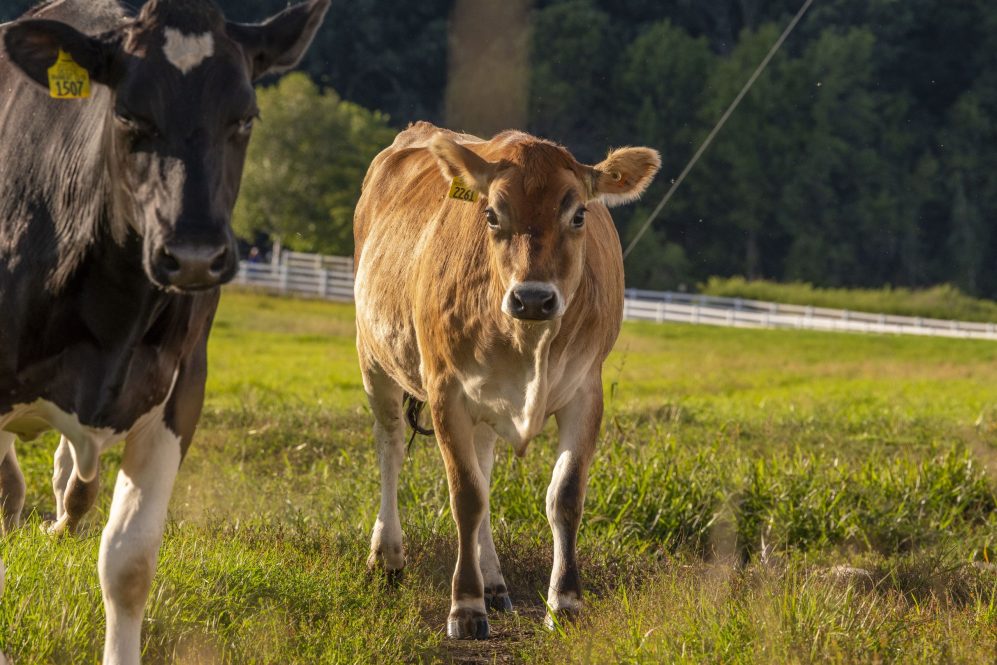A multi-institutional, international effort known as the Ruminant Telomere-to-Telomere consortium, or RT2T, is aiming to make scientific history by publishing the complete genomes of over 300 species of ruminant animals, ranging from narwhals to dairy cows.
This initiative builds on other recent T2T consortium successes, such as the June 2024 publication of the complete sequencing of six ape species genomes and the August 2023 publication of the first-ever complete human Y chromosome sequence.
At UConn, Rachel O’Neill, director of the Institute for Systems Genomics and Board of Trustees Distinguished Professor of molecular and cell biology, has had a hand in all these victories.
For the RT2T, O’Neill explains, “My lab is generating some of the data, and we’re doing quite a bit of biobanking of cell lines – establishing cell lines for many of the endangered or critically endangered species, where there isn’t a repository that exists already.”
The O’Neill lab will also be responsible for performing the repeat analysis – detangling and decoding many thousands of repeated, short sequences of DNA – for each species.
“That’s kind of a giant task, because the largest amount we’ve ever done before is what we just completed for the primates – six species,” O’Neill says.
Historically, studying the genetics of ruminant animals has been challenging due to missing, incomplete and/or fragmented reference genome sequences. These limitations have impeded a comprehensive understanding of genetic traits and behaviors across the ruminant phylogenetic group. However, the RT2T project, leveraging cutting-edge sequencing technologies and collaborative expertise, aims to provide a foundation that will eliminate many of these barriers.
The project, published in Nature Genetics, describes how the worldwide team of collaborators will leverage advanced sequencing technologies to analyze the genomes of ruminant species. These methods provide a comprehensive view of the genome, including previously hard-to-sequence regions like centromeres and telomeres (key structures within chromosomes, each playing crucial roles in cell division and maintaining genetic stability), thus offering a complete genetic blueprint of these animals.
Without that genetic blueprint, O’Neill explains, “conservation management strategies become impossible; understanding genome biology becomes impossible, because we’re literally blind. It’s like having a book with every third word cut out randomly and having to decipher its meaning.”
RT2T embraces an open science model, ensuring that the data and results produced are freely accessible to the global research community. Scientists worldwide can access this data to conduct further studies, fostering innovations that could reshape farming practices and animal breeding.
The Future of Genomic Research in Agriculture
For livestock ruminants (sheep and cattle), genomic research can help enable more efficient milk and dairy production and help reduce the risk of infectious diseases spreading from livestock to humans.
This “dovetails quite well” with UConn’s strengths in research agriculture, according to O’Neill.
“It’s quite fortuitous that this is happening,” she says. “I’ve collaborated with several labs over the past 10 to 15 years where Ph.D. students were desperate for a good genome assembly, and it’s refreshing to be able to say one is really coming and to invite those teams to play with that genome as it comes out.”
As the RT2T project advances, its research is anticipated to yield insights into the evolutionary biology of ruminants, informing targeted breeding programs that enhance livestock resilience and productivity. By understanding the genetic history of ruminants, breeders can implement strategies to conserve valuable traits and adapt to changing environmental conditions.
Applications in Conservation and Biodiversity Management
In addition to agricultural benefits, the comprehensive genome data produced by the RT2T can play a critical role in conservation efforts. High-quality genomic information is essential for managing the genetic diversity of endangered ruminant species and developing strategies to improve their populations’ survival chances.
Genome sequencing can unlock the entire genetic history of a population. For example, O’Neill says, conservation managers can use it to determine whether a population has undergone inbreeding, which can harm its long-term survival, and help re-diversify it by translocating individual animals from other populations.
If a group of animals is discovered to have inbreeding depression, O’Neill explains, “That means they’ve gone through some sort of population decline at some point. And we can, from one genome, look into the past and actually model population density over time and figure out, is that population crash recent? Is it because of the Anthropocene, or is it more ancient? Those are the kinds of things conservation managers are looking for.”
Research associates in O’Neill’s lab working on the RT2T include Jessica Storer, Gabrielle Hartley, Patrick Grady, Emry Brannan, Savannah Hoyt, Nicole Pauloski, Christine McCann, and Vel Johnston.
This research was supported by the intramural research program of the U.S. Department of Agriculture, National Institute of Food and Agriculture, Grant Number 2023-67015-39000.
Other participating organizations in the RT2T include the University of Kentucky, the University of Missouri, the University of Idaho, the University of Adelaide (Australia), Universidad de la República (Uruguay), Purdue University, Virginia Polytechnic Institute and State University, the University of Colorado Boulder, the University of Edinburgh (UK), AgResearch Ltd (New Zealand), Utah State University, the Livestock Improvement Corporation (New Zealand), Texas A&M University, Université de Toulouse (France), the Animal Genomics and Improvement Laboratory (Maryland, US), the University of California Davis, Oklahoma State University, the U.S. Meat Animal Research Center (Nebraska, US), Michigan State University, The Rockefeller University, the University of Wisconsin-Madison, Iowa State University, the National Human Genome Research Institute (Maryland, US), Friedrich-Loeffler-Institute (Germany), the University of Bern (Switzerland), ETH Zurich (Switzerland), the University of California Santa Cruz, Washington State University, the University of Southern California, the Stowers Institute for Medical Research (Missouri, US), Pennsylvania State University, the University of Alberta (Canada), the University of Louisville (Kentucky, US), and the Research Institute for Farm Animal Biology (Germany).



